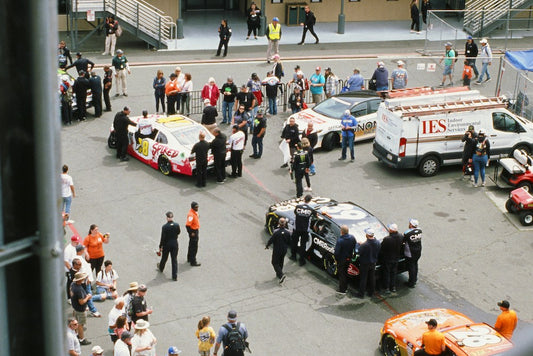NASCAR Economics: Sponsorship Dynamics and Financial Footprints

NASCAR, short for the National Association for Stock Car Auto Racing, is one of the most popular and lucrative sports in the United States. Known for its high-speed races and passionate fan base, NASCAR has become a cultural phenomenon that attracts millions of viewers and spectators each year.
However, behind the thrilling races and iconic drivers, lies a complex economic ecosystem that drives the sport forward. In this article, we will delve into the economics of NASCAR, with a particular focus on sponsorship dynamics and the financial impact of the sport.
Sponsorship Dynamics in NASCAR
In simple terms, sponsorship refers to the financial support provided by companies or organizations to teams and drivers in exchange for exposure and advertising opportunities. This financial backing allows teams to cover their operating costs, invest in research and development, and compete at the highest level.
There are various types of sponsorships in NASCAR, ranging from primary sponsors who have their logos prominently displayed on the car, to associate sponsors who have a smaller presence. Additionally, teams may also secure product sponsorships, where companies provide goods or services in exchange for exposure. The sponsorship landscape in NASCAR is highly competitive, with teams constantly vying for the best deals to secure their financial stability.
Prominent sponsors such as Coca-Cola and Toyota have long been associated with NASCAR. These companies recognize the immense marketing potential that comes with sponsoring a team or driver in the sport. By aligning their brand with NASCAR, they can reach a wide and diverse audience of passionate fans. The financial support provided by these sponsors allows teams to invest in state-of-the-art equipment and technology, giving them a competitive edge on the track.
The Financial Impact of NASCAR
The economic impact of NASCAR extends far beyond the racetrack: The sport contributes significantly to job creation and local economies. Race weekends bring in thousands of fans who spend money on tickets, accommodations, food, and merchandise, creating a boon for local businesses. Additionally, the construction and maintenance of racetracks also provide employment opportunities for local communities.
Ticket sales and revenue generation are crucial to the financial health of NASCAR: The sport relies heavily on the income generated from ticket sales, with race weekends being a major source of revenue. The NASCAR fan base is known for its loyalty and passion, with fans traveling from all over the country to attend races. The revenue generated from ticket sales not only supports the teams and drivers but also helps fund the operation and promotion of the sport.
Television rights and broadcasting deals are another significant source of revenue for NASCAR: Networks such as Fox and NBC pay substantial sums to broadcast NASCAR races, providing exposure to millions of viewers. These broadcasting deals not only generate revenue but also help promote the sport, attracting new fans and sponsors.
Moreover, host cities also benefit economically from hosting NASCAR races: The influx of fans and the media coverage generated by the races bring attention and tourism to the area. Hotels, restaurants, and local businesses experience increased patronage, boosting the local economy.
Challenges
While NASCAR is a lucrative sport, it is not without its challenges in terms of economics. One of the primary challenges is the cost of sponsorship and the financial burden it places on teams: Securing a sponsorship deal can be costly, and teams often rely heavily on these deals to cover their expenses. The rising costs of operating a team, from salaries to equipment, put immense pressure on teams to secure and maintain sponsors.
Another challenge is the difficulty in securing and maintaining sponsors: The competitive nature of the sponsorship landscape means that teams constantly have to prove their value to sponsors. With the ever-changing business landscape, sponsors may choose to reallocate their marketing budgets to other platforms, leaving teams scrambling to find new sponsors. This uncertainty can create financial instability for teams and impact their ability to compete at the highest level.
Furthermore, NASCAR has faced challenges in recent years with declining attendance and TV viewership: The sport has seen a decline in ticket sales, with some races experiencing empty seats in the stands. Additionally, TV viewership has also dropped, with changing media consumption habits and increased competition from other sports and entertainment options. These challenges have forced NASCAR to adapt and find new ways to engage fans and attract sponsors.
The Economics of NASCAR
Beyond the financial aspects, there are several interesting details in the economics of NASCAR. One fascinating aspect is the various levels of sponsor involvement and financial commitment: Some sponsors choose to have their logos prominently displayed on the car, while others opt for a more subtle presence. The financial commitment of sponsors can vary greatly, with some sponsors providing significant financial backing, while others offer product sponsorships or discounts.
Sponsorship also has a significant impact on car design and technology: Sponsors often play a role in determining the paint scheme and design of the car, ensuring that their brand is well-represented. Additionally, sponsors may also provide technical expertise or resources to teams, helping them develop innovative technologies that improve performance on the track.
Moreover, sponsorships have a profound impact on fan loyalty and support: Fans often develop a connection with the sponsors associated with their favorite teams and drivers. They may choose to support these sponsors by purchasing their products or services, further strengthening the relationship between the sponsor, team, and fan.
Beyond Sponsorship
While sponsorship is a critical component of NASCAR economics, there are other aspects that contribute to the overall economic impact of the sport. The economic contribution of hosting race events cannot be understated: Cities that host NASCAR races experience a significant boost in tourism and local spending. Hotels, restaurants, and other businesses benefit from the influx of fans and media coverage, making hosting a NASCAR race a valuable opportunity for economic growth.
NASCAR also has a substantial impact on related industries such as tourism and merchandising: Fans often plan vacations around attending NASCAR races, leading to increased tourism in the host cities. Additionally, the sale of NASCAR merchandise, from t-shirts to die-cast cars, generates significant revenue for both teams and manufacturers.
Furthermore, comparing NASCAR with other sports and their economic models provides valuable insights: NASCAR operates differently from traditional stick-and-ball sports, with its unique sponsorship-driven model. Understanding these differences can shed light on the strengths and weaknesses of the NASCAR economic ecosystem.
Conclusion
In conclusion, the economics of NASCAR are complex and multifaceted, with sponsorship dynamics and financial footprints playing a crucial role. Sponsorship provides the financial backing necessary for teams and drivers to compete at the highest level. Additionally, NASCAR's economic impact extends beyond the racetrack, contributing to job creation, local economies, and the promotion of host cities.
However, NASCAR also faces challenges in terms of securing and maintaining sponsors, as well as declining attendance and TV viewership. These challenges require innovative solutions and adaptations to ensure the long-term sustainability of the sport.





